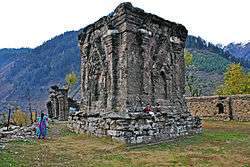Kalat Kali Temple
| Kali Temple, Kalat | |
|---|---|
|
Om | |
 Kali Temple, Kalat Location within Pakistan | |
| Geography | |
| Coordinates | 29°01′49″N 66°34′48″E / 29.0304°N 66.58°ECoordinates: 29°01′49″N 66°34′48″E / 29.0304°N 66.58°E |
| Culture | |
| Primary deity | Kali |
| Consort | Shiva |
| Festival deity | Kali |
| Architecture | |
| Architectural styles | Hindu temple |
| Number of temples | 1 |
| Number of monuments | 1 |
| Inscriptions | 2 |
| History and governance | |
| Governing body | Pakistan Hindu Council |
| Website | http://www.pakistanhinducouncil.org/ |
Kali Mandir, Kalat is a Hindu temple located in Kalat, Pakistan in Balochistan devoted to the Hindu goddess Kali.[1]
History
Kalat has two percent Hindu population.[2] In addition, there are some Hindu Hindkowan merchants who have settled in Kalat.[3][4]
Kalat's Kali Devi temple is a Hindu mandir below citadel of the Kalat princely state, dedicated to Goddess Kali; this mandir dates back to pre-Islamic era of South Asia.
It has been known in earlier times as Kalat-i-Seva (from a legendary Hindu king) and Kalat-i Nicari which connects it with the Brahui Speaking Baloch tribe of Nicari , which is generally accepted as belonging to the oldest branch of the indigenous Brahois[5]
The town of Kalat is said to have been founded by and named Qalat-e Sewa (Sewa's Fort), after Sewa, a legendary hero of the local Baloch.
In 1947, the Khan of Kalat reportedly acceded to the dominion of India. But his accession papers were returned by Jawaharlal Nehru, the Prime Minister of India.[6][7][8] Afterwards, Mir Ghaus Baksh Bizenjo, President of the Kalat State National Party, went to Delhi and met Congress President Maulana Abul Kalam Azad. Azad argued that Kalat would never be able to survive as a sovereign, independent state and would have to ask for British protection. Such a demand, Azad said, would render the sovereignty of the subcontinent meaningless. This was why Indian help for Kalat was ruled out. In 1948, Qalat became part of Pakistan when the British withdrew.
External links
See also
References
- ↑ Daily Times article on Varun Dev Temple
- ↑ Encyclopædia Britannica: a new survey of universal knowledge, Volume 3. Encyclopœdia Britannica. Retrieved 2008-08-17.
Almost all the people are Muslim ; the largest Hindu minorities are in the Sibi (9%) and Kalat (2%) districts.
- ↑ Viking fund publications in anthropology, Issue 43. Viking Fund. Retrieved 2008-08-17.
...is in the hands of a small caste of Hindu merchants. These Hindus are Hindko-speaking and regard Kalat as their homeland, where they generally keep their families and go for some months every year to visit and to obtain supplies. While in the Marri area, they must be under the protection of a local Marri chief or the sardar himself.
- ↑ The social organization of the Marri Baluch. Indus Publications. Retrieved 2008-08-17.
...is in the hands of a small caste of Hindu merchants. These Hindus are Hindko-speaking and regard Kalat as their homeland, where they generally keep their families and go for some months every year to visit and to obtain supplies. While in the Marri area, they must be under the protection of a local Marri chief or the sardar himself.
- ↑ E.J. Brill's first encyclopaedia of Islam, 1913-1936, Volume 4 By M. Th. Houtsma, Martijn Theodoor Houtsma Page 678
- ↑ "Mainstream". 28 (32-52). N. Chakravartty. 1990: 9.
- ↑ Rajinder Puri (1992). Recovery of India. Har-Anand Publications. p. 74.
- ↑ Strategic Studies, Volume 26. Islamabad: Institute of Strategic Studies. 2006. p. 44.


